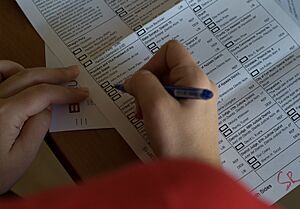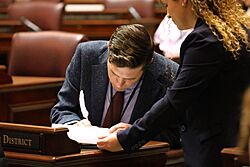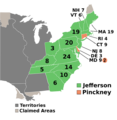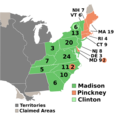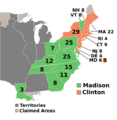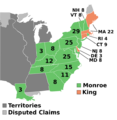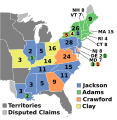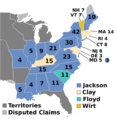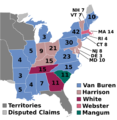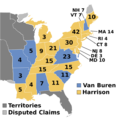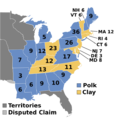United States presidential election facts for kids
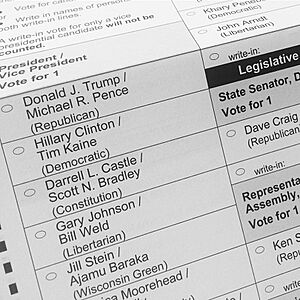
Choosing the President and Vice President of the United States is a big event! It happens through a special process called an indirect election. This means people don't vote directly for the President. Instead, they vote for a group of people called the Electoral College. These electors then cast the actual votes for President and Vice President. To win, a candidate needs at least 270 out of 538 electoral votes. If no one gets enough votes for President, the House of Representatives decides. If no one gets enough for Vice President, the Senate decides.
Many countries choose their leaders with a direct vote, where the person with the most votes wins. But in the U.S., it's different. The Electoral College system is set up in the U.S. Constitution. Each state gets a certain number of electoral votes. This number is based on how many Senators and Representatives that state has in Congress. For example, a state with more people has more Representatives, so it gets more electoral votes. Even Washington, D.C. gets three electoral votes. Each state's government decides how its electors are chosen. In the past, state lawmakers picked the electors. But now, people vote for them directly. State laws also decide who can vote and how to register.
Most states use a 'winner-takes-all' system. This means the candidate who gets the most votes in that state wins all of its electoral votes. Only two states, Nebraska and Maine, divide their electoral votes differently. They give some votes based on who wins in specific areas of the state.
Sometimes, an elector might vote for someone different than who their state voted for. These are called 'faithless electors'. But this rarely happens, and it has not changed the final election results in modern times.
Usually, the candidate who wins the Electoral College also wins the most votes from people across the country. But this has not always been the case. In a few elections, like in 2000 and 2016, the winner of the Electoral College did not win the most individual votes nationwide. This happens because winning by a small amount in many states can add up to more electoral votes.
The 1824 election was special because no candidate won enough electoral votes. So, the House of Representatives chose the President. The person they picked did not have the most votes from the people or the most electoral votes.
Presidential elections happen every four years. Election Day is always the first Tuesday after the first Monday in November. On this day, people also vote for other government jobs, like members of Congress. Local governments help run these elections. After Election Day, the Electoral College members meet in December to cast their votes. Then, in early January, Congress officially counts the votes. The new President starts their term on Inauguration Day, which is January 20.
Before the main election, political parties choose their candidates. This is called the nomination process. It involves primary elections and caucuses (meetings) in each state. These usually happen from January to June. Then, in the summer, parties hold big meetings called nominating conventions. At these conventions, delegates (people chosen by voters) pick the party's official candidate for President. The candidate then chooses a Vice President to run with them. Many candidates announce they are running almost two years before the election. This gives them time to raise money for their campaigns.
Contents
History
How the Electoral College Started
The idea for the Electoral College is in Article Two of the Constitution. It was a compromise. Some of the country's founders wanted Congress to pick the President. Others wanted people to vote directly. The Electoral College was a middle ground.
Each state gets a number of electors based on its total number of Senators and Representatives. In 1961, Washington, D.C. also got electors, just like the smallest states. But U.S. territories do not have electors.
How States Choose Electors
The Constitution says each state's lawmakers decide how to choose electors. In the very first election in 1789, some states let people vote for electors directly. Other states had their lawmakers choose them. Some even used a mix of both.
Over time, more and more states let people vote directly for electors. By 1824, most states used a popular vote. This was part of a bigger movement towards more democracy. By 1872, all states chose their electors through a popular vote. Today, only Maine and Nebraska use a slightly different method, where some electors are chosen by district.
Changes for Vice Presidents
Originally, electors voted for two people for President. The one with the most votes became President, and the second-place person became Vice President. This caused a problem in the 1800 election. Thomas Jefferson and Aaron Burr tied, and the House of Representatives had to decide. Jefferson won.
Because of this tie, the Twelfth Amendment was added. It made electors vote separately for President and Vice President. Now, the President and Vice President run together as a team, or 'ticket'.
What Happens in a Tie
The Twelfth Amendment also explains what happens if no one wins a majority of electoral votes. This happened in the 1824 election. Andrew Jackson had the most votes, but not a majority. So, the House of Representatives chose John Quincy Adams as President.
In that election, the Vice President was chosen easily, so the Senate did not need to vote.
The Popular Vote
Since 1824, the person who wins the most votes in each state usually wins that state's electoral votes. Most of the time, the candidate who wins the most votes across the whole country also wins the Electoral College. This has happened in about 9 out of 10 elections. When the popular vote winner and the Electoral College winner are different, it's usually because the election was very close.
As mentioned, in 1824, Andrew Jackson won the most individual votes, but the House chose John Quincy Adams. This led to some people saying there was a 'corrupt bargain'.
In five elections, the person who won the Electoral College did not win the most votes from the people. These were in 1824, 1876, 1888, 2000, and 2016. Because of this, some people want to change the system so the person with the most votes nationwide always wins. But so far, no changes have been made to the Constitution.
The Electoral Count Act
After a very close and disputed election in 1876, Congress passed the Electoral Count Act in 1887. This law set clear rules for how electoral votes are counted. It helps make sure there are no arguments about which electors are valid.
Campaign Money Rules
Laws about campaign money, like the Federal Election Campaign Act from 1971, help make sure people know where campaign money comes from. Candidates have to tell the government when they start raising or spending a lot of money. This is why many candidates announce they are running very early. It gives them time to gather funds for their campaigns.
Political Parties and Elections
The U.S. Constitution does not mention political parties. The country's founders did not plan for them. The first President, George Washington, did not belong to a party. But since 1796, almost all Presidents have belonged to one of the two main parties. Sometimes, smaller 'third parties' try to win, but it is very rare for them to get many votes.
How Candidates are Chosen
In the early days, the Electoral College helped choose candidates. Later, party leaders in Congress or state lawmakers picked them. But this changed over time. Since 1832, parties have used big meetings called national conventions to choose their candidates. At first, these meetings were not always very open.
Later, people wanted voters to have more say. So, primary elections became popular. Florida held the first presidential primary in 1901. In a primary, people vote for their favorite candidate directly. This helps show what voters want. After the 1968 election, rules changed to make sure more people could take part in choosing candidates. This led to many more states using primaries.
Procedure
Who Can Be President?
To be President, a person must be a natural-born citizen of the U.S. They must be at least 35 years old. They also need to have lived in the U.S. for at least 14 years. These rules are in Article Two of the Constitution. A President can only be elected for two terms, thanks to the Twenty-second Amendment.
There are also other rules. If a President is removed from office through a process called impeachment, the Senate can stop them from holding any future public office. Also, the Fourteenth Amendment says that someone who has rebelled against the U.S. government cannot hold federal office, unless Congress allows it.
The Vice President must meet the same requirements as the President.
Candidates often announce they are running very early. This is because of rules about campaign money. They need to tell the Federal Election Commission if they plan to raise or spend a lot of money. This helps them start their campaigns and gather support.
How Elections are Run
Elections in the U.S. are run mostly by each state. The U.S. Constitution sets some basic rules. But state laws decide many things. This includes how primaries work and who can vote. Each state also manages its own Electoral College meeting.
So, the presidential election is like 50 separate state elections happening at once. Candidates have to follow different rules in each state to get their name on the ballot.
Who Can Vote?
The Constitution says that citizens cannot be stopped from voting because of their race, gender, or if they are 18 or older. Beyond these rules, each state decides who can vote and how to register. For example, some states have rules about people who have committed serious crimes.
The Nomination Process
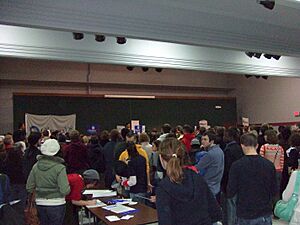
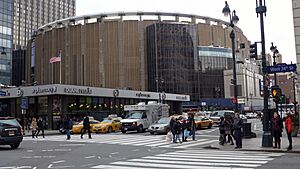
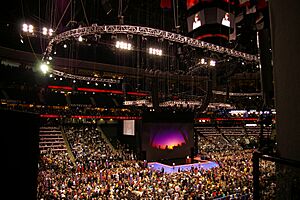
Today, choosing a presidential candidate has two main parts. First, there are primary elections and caucuses in each state. Second, there are big nominating conventions for each political party. This system grew over time to help parties pick their best candidate.
State and local governments run primaries. Political parties organize caucuses. Some states use only primaries, some only caucuses, and some use both. These events happen from January to June before the main election. Iowa and New Hampshire are usually the first states to hold them.
When people vote in a primary or caucus, they are choosing delegates. These delegates then go to the national convention. At the convention, they vote for the party's presidential candidate. Sometimes, delegates must vote for the candidate their state chose. Other times, they can vote as they wish.
People in U.S. territories can vote for delegates to these conventions, even though they don't vote in the main election. Each party has its own way of deciding how many delegates each state and territory gets. For example, the Democrats and Republicans use different rules to figure this out.
Besides the delegates chosen by voters, there are also 'unpledged' delegates. These are usually party leaders or elected officials. They can vote for any candidate they want at the convention. Democrats call some of their unpledged delegates 'superdelegates'.
The presidential candidate then picks a Vice President to run with them. The convention usually approves this choice.
If no candidate wins enough delegates, it can lead to a 'brokered convention'. This means delegates are free to change their votes. The party then works to find a candidate everyone can agree on.
These conventions are often held in large sports arenas or stadiums. This is because many people attend them.
Campaign Strategies
To win an election, candidates need a good plan, or campaign strategy. The main goal is to get their supporters to vote and to convince people who haven't decided yet. Political experts say a good strategy involves a few steps. First, campaigns figure out who their strong supporters are, who supports their opponents, and who is still undecided. They use past election results and surveys to do this. Campaigns focus on keeping their supporters happy and trying to win over the undecided voters. They know they don't need every single vote. Finally, they use their money and time wisely to reach these voters.
Campaigns use many ways to get their message out. TV ads are expensive but reach many people. However, talking to voters in person is often the most effective way to convince them. It works better than emails or phone calls.
Voting on Election Day
On Election Day, people vote for President. Each state's government decides how its electors are chosen. Most states now let people vote directly for electors. In the past, some states had their lawmakers choose the electors.
Federal law says all electors must be chosen on the same day. This day is always the first Tuesday after the first Monday in November. On this day, states and Washington, D.C. hold their elections. The votes help decide which electors will represent their state.
When you vote for President, you are actually voting for a group of electors. These electors have promised to vote for a specific presidential and vice presidential team.
On the ballot, you can often vote for all candidates from one party. Or you can pick individual candidates. Getting a candidate's name on the ballot is a legal process. Usually, only candidates from major parties are listed automatically. Smaller parties or independent candidates need to collect many signatures to get on the ballot.
Some people write in a candidate's name if it's not on the ballot. This is called a 'write-in' vote. But for a write-in candidate to win, they usually need to have a group of electors ready to vote for them. No write-in candidate has ever won a state's presidential election. Sometimes, people write in funny names to show they don't like the main candidates.
People in U.S. territories do not vote in the main presidential election. This is because their areas are not part of the Electoral College. Some territories, like Guam, hold their own unofficial votes to show their opinions.
How the Electoral College Works
After Election Day, most states give all their electoral votes to the candidate who won the most votes in that state. This is called 'winner-take-all'. But Maine and Nebraska are different. They split their electoral votes based on who wins in different parts of the state.
The winning electors meet in their state capitals in December. They cast their votes for President and Vice President. While the Constitution allows electors to vote for anyone, many states have laws against 'faithless electors'. These are electors who vote differently than they promised. The Supreme Court has said that states can punish or replace these electors.
In early January, the Vice President (who is also the President of the Senate) officially counts the electoral votes. This happens in front of both houses of Congress. Members of Congress can object to votes, but both the House and Senate must agree to remove them. This process makes sure the election results are official.
If no candidate gets 270 electoral votes, the House of Representatives chooses the President. Each state delegation gets one vote. The Senate then chooses the Vice President. The House has only chosen the President twice, in 1800 and 1824. The Senate has chosen the Vice President only once, in 1836.
If a President is not chosen by Inauguration Day, the Vice President-elect becomes acting President. If neither is chosen, Congress decides who will act as President.
Usually, the winner is clear after Election Day. The steps in December and January are mostly formal. The person who is expected to win is called the 'President-elect'.
Election Timeline
The presidential election process follows a timeline:
- Candidates often announce they are running about two years before the election.
- Primary elections and caucuses happen from January to June in the election year.
- Political parties hold their big nominating conventions in the summer.
- Presidential debates take place in September and October.
- Election Day is in November.
- Electors cast their votes in December.
- Congress officially counts the votes in early January.
- The new President starts their term on Inauguration Day, January 20.
Trends
Past Experience of Presidents
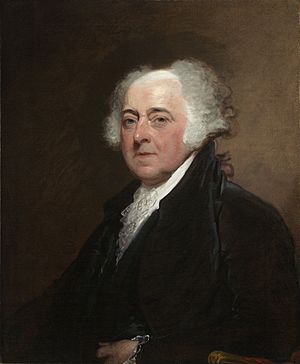
Most U.S. Presidents had experience in government or the military before taking office. For example, many were Vice Presidents, members of Congress, or state governors. Only Donald Trump had not held a government or military job before becoming President. Some Presidents, like Zachary Taylor and Dwight D. Eisenhower, were military leaders.
Fifteen Presidents were also Vice Presidents. Some, like Joe Biden, won the election after being Vice President. Others became President because the President before them left office or passed away. For example, Theodore Roosevelt and Harry S. Truman became President this way and were later elected for their own terms. Gerald Ford is the only President who was never elected to either the Vice Presidency or the Presidency.
Many Presidents served in the U.S. Senate or House of Representatives before becoming President. Only a few, like Barack Obama, were serving as Senators when they were elected President.
Sixteen Presidents were once state governors. Recently, Presidents like Bill Clinton and George W. Bush were governors before they became President.
The most common job for a President has been a lawyer; 26 Presidents were attorneys. Many also served in the military. Some were also Cabinet Secretaries, like the Secretary of State.
After being President, William Howard Taft became the Chief Justice of the United States. John Quincy Adams and Andrew Johnson later served in Congress.
Technology and Campaigns
New technologies have changed how presidential campaigns work. First, radio and then television became very important. Candidates used TV ads to reach many voters. Famous ads include Lyndon B. Johnson's 'Daisy' and Ronald Reagan's 'Morning in America'.
The internet became a key part of campaigns in the 2000s. In 1996, it was mostly used for simple websites. But by 2004, candidates like Howard Dean used their websites to connect with supporters. People could learn about his ideas, donate, and get involved.
By 2004, many Americans used the internet to learn about candidates. Websites became places for supporters to get involved and donate money.
The internet also made it easier for candidates to raise money from many small donors. In 2016, social media became very important. Candidates like Donald Trump used platforms like Twitter to share their messages daily. They also used sites like YouTube to share speeches and ads.
Studies show that many adults use the internet to get election information. Social media and cell phones are also widely used to learn about and discuss campaigns.
Rules for online campaigning, or 'e-campaigning', are less strict. In 2006, the Federal Election Commission decided not to regulate most online political messages. This means things like emails and blogs are not limited in the same way as paid ads. This allows for a lot of online activity that doesn't have to be reported.
Candidates also use media to shape how people see them and their opponents. This is called 'framing'. For example, in the 2016 election, Donald Trump used certain phrases to describe Hillary Clinton. This influenced how some voters thought about her. Trump's campaign focused on making people feel the country needed big changes. His slogan, 'Make America Great Again', suggested a time of loss. This made some voters willing to choose a candidate without political experience. Media coverage often focused on who was winning, rather than on specific issues.
Voter Participation
The number of people who vote in presidential elections changes over time. Voter turnout increased in the 2004 and 2008 elections. Before that, it had been going down. Experts debate why this happens. Some think it's because people care less, while others point to changes in who is eligible to vote. In 2008, about 61.7% of eligible voters cast a ballot. This was the highest turnout since 1968.
Sharing Financial Information
It has become a tradition for presidential candidates to share some of their financial information. This includes things like their tax returns. This helps the public trust them. In 1967, George W. Romney shared his tax returns for 12 years. Since then, many candidates have shared some of their tax information.
However, in 2016, Donald Trump did not release his full tax returns. He said it was because he was being audited by the IRS. But other Presidents, like Richard M. Nixon, had released their tax returns even when they were being audited.
Presidential 'Coattails'
Presidential elections happen on the same day as many other elections. These include all seats in the House of Representatives and some seats in the Senate. When a popular presidential candidate runs, their supporters often vote for other candidates from the same party. This is called the 'coattail effect'. More people usually vote in presidential election years than in other election years.
Since World War II, some presidential elections have had a big 'coattail effect'. This means the winning President's party also gained many seats in Congress. For example, Barack Obama's win in 2008 helped his party gain control of the Senate.
| Year | Elected president | President's party | Net gain/loss of president's party | |
|---|---|---|---|---|
| House seats | Senate seats | |||
| 1948 | Harry S. Truman | Democratic | +75: (188 ► 263) | +9: (45 ► 54) |
| 1952 | Dwight D. Eisenhower | Republican | +22: (199 ► 221) | +2: (47 ► 49) |
| 1956 | -2: (203 ► 201) | 0: (47 ► 47) | ||
| 1960 | John F. Kennedy | Democratic | -21: (283 ► 262) | -1: (65 ► 64) |
| 1964 | Lyndon B. Johnson | Democratic | +37: (258 ► 295) | +2: (66 ► 68) |
| 1968 | Richard Nixon | Republican | +5: (187 ► 192) | +5: (37 ► 42) |
| 1972 | +12: (180 ► 192) | -2: (44 ► 42) | ||
| 1976 | Jimmy Carter | Democratic | +1: (291 ► 292) | 0: (61 ► 61) |
| 1980 | Ronald Reagan | Republican | +34: (158 ► 192) | +12: (41 ► 53) |
| 1984 | +16: (166 ► 182) | -2: (55 ► 53) | ||
| 1988 | George H. W. Bush | Republican | -2: (177 ► 175) | -1: (46 ► 45) |
| 1992 | Bill Clinton | Democratic | -9: (267 ► 258) | 0: (57 ► 57) |
| 1996 | +2: (204 ► 206) | -2: (47 ► 45) | ||
| 2000 | George W. Bush | Republican | -2: (223 ► 221) | -4: (54 ► 50) |
| 2004 | +3: (229 ► 232) | +4: (51 ► 55) | ||
| 2008 | Barack Obama | Democratic | +21: (236 ► 257) | +8: (51 ► 59) |
| 2012 | +8: (193 ► 201) | +2: (53 ► 55) | ||
| 2016 | Donald Trump | Republican | -6: (247 ► 241) | -2: (54 ► 52) |
| 2020 | Joe Biden | Democratic | -13: (235 ► 222) | +3: (47 ► 50) |
| 2024 | Donald Trump | Republican | -2: (222 ► 220) | +4: (49 ► 53) |
Images for kids
-
Electoral College map showing results of the 2020 U.S. presidential election. Democrat Joe Biden won the popular vote in 25 states (blue) plus D.C. and Nebraska's 2nd congressional district to capture 306 electoral votes. Republican Donald Trump won the popular vote in 25 states (red) and in Maine's 2nd congressional district to capture 232 electoral votes.
See also
 In Spanish: Elecciones presidenciales en Estados Unidos para niños
In Spanish: Elecciones presidenciales en Estados Unidos para niños


